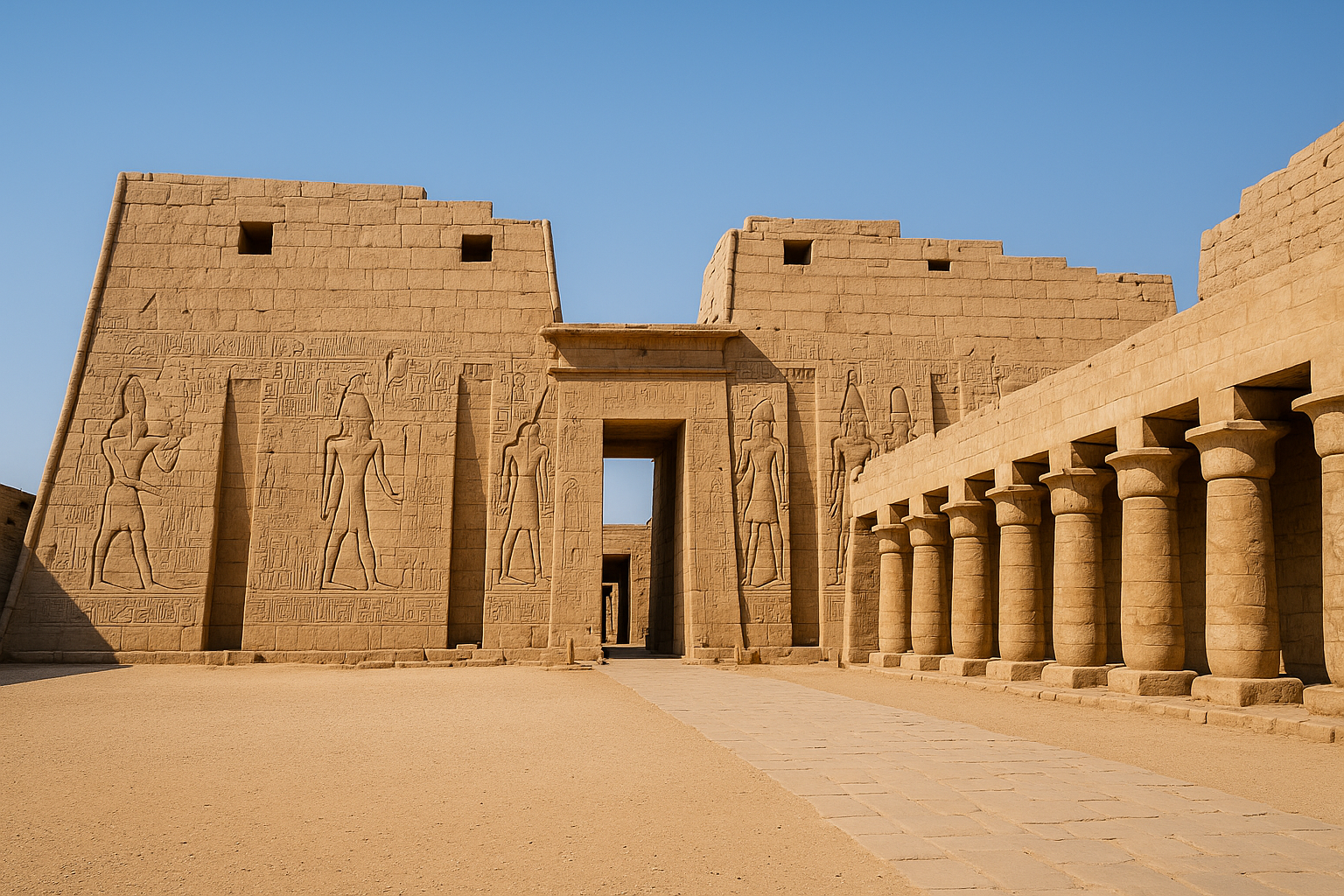Luxor is filled with ancient treasures, but few sites are as captivating and historically rich as the Temple of Medinet Habu. Located on the West Bank of Luxor, the Temple of Medinet Habu is the mortuary temple of Pharaoh Ramses III, the last great warrior pharaoh of Egypt. Known for its monumental architecture, stunningly preserved reliefs, and vivid battle scenes, the Temple of Medinet Habu offers travelers a rare glimpse into the glory, challenges, and daily life of New Kingdom Egypt.
In this article, we’ll dive deep into the Temple of Medinet Habu, exploring its history, design, artwork, and why it deserves a spot on every traveler’s Luxor itinerary.
History of the Temple of Medinet Habu
The Temple of Medinet Habu was built during the reign of Ramses III (1186–1155 BCE), who modeled it after the mortuary temple of Ramses II, the Ramesseum. Ramses III constructed the Temple of Medinet Habu to serve as both a place of worship and a memorial for his reign.
The temple complex became not only a religious site but also a fortified administrative center. With massive mudbrick walls surrounding it, the Temple of Medinet Habu functioned as a stronghold, housing priests, scribes, and artisans who supported temple activities.
Ramses III’s reign is remembered for its military conflicts, particularly his battles against the Sea Peoples. Many of these victories are immortalized on the walls of the Temple of Medinet Habu, making it a unique combination of propaganda, history, and art.
Design and Architecture of the Temple of Medinet Habu
The Temple of Medinet Habu is one of the largest temple complexes in Luxor, measuring over 320 meters long and 200 meters wide. Its layout follows the traditional design of New Kingdom mortuary temples, beginning with colossal pylons that lead into vast courtyards and sanctuaries.
Key features include:
- First Pylon: Decorated with scenes of Ramses III smiting his enemies and depictions of the military campaigns against the Sea Peoples.
- First Courtyard: Surrounded by towering columns and colossal statues, this courtyard emphasizes Ramses III’s divine authority.
- Second Pylon and Hypostyle Hall: Containing richly decorated columns, these halls depict religious ceremonies and offerings to the gods.
- Sanctuary: The innermost part of the Temple of Medinet Habu, dedicated to Amun, the chief deity of Thebes.
The complex also included chapels for other gods, administrative buildings, and even residential quarters for the temple staff, making the Temple of Medinet Habu a bustling hub of activity.
The Stunning Reliefs of the Temple of Medinet Habu
One of the most remarkable features of the Temple of Medinet Habu is its extensive reliefs. The walls are covered with vibrant depictions of military campaigns, religious rituals, and scenes of daily life.
- Battle Reliefs: The most famous carvings show Ramses III’s victories over the Sea Peoples, who threatened Egypt during his reign. These reliefs remain some of the most detailed records of ancient warfare in Egypt.
- Religious Scenes: Depictions of the pharaoh offering gifts to the gods highlight his role as the divine intermediary.
- Daily Life: Scenes of agriculture, feasting, and temple rituals provide insights into how ancient Egyptians lived and celebrated.
The colors of many reliefs at the Temple of Medinet Habu are still visible today, making it one of the best-preserved temples in Luxor for travelers who want to experience the vibrancy of the ancient world.
Symbolism and Power at Medinet Habu
The Temple of Medinet Habu was not just an architectural marvel; it was also a symbol of Ramses III’s authority and divine right to rule. The temple’s inscriptions and artwork were designed to reinforce the idea that Ramses III was chosen by the gods to defend Egypt and maintain order.
The fortress-like design of the Temple of Medinet Habu also symbolized protection, not only for the pharaoh in the afterlife but also for the Egyptian people during times of external threats.
Rediscovery and Excavation of the Temple of Medinet Habu
The Temple of Medinet Habu was well-known in antiquity, but like many sites in Luxor, it fell into ruin over the centuries. In the 19th and 20th centuries, archaeologists rediscovered and began systematically studying the temple. Excavations revealed its full scale and the extraordinary preservation of its reliefs.
Today, the Temple of Medinet Habu is recognized as one of the most important archaeological sites in Egypt, offering unparalleled insights into the New Kingdom.
Infographic: Highlights of the Temple of Medinet Habu
Temple of Medinet Habu at a Glance
- Built by Ramses III (1186–1155 BCE)
- Largest mortuary temple in Luxor’s West Bank
- Famous for battle reliefs against the Sea Peoples
- Still retains vivid original colors on reliefs
- Served as both a temple and fortified administrative center

Visiting the Temple of Medinet Habu Today
For modern travelers, visiting the Temple of Medinet Habu is an unforgettable experience. Unlike the more crowded Karnak and Luxor Temples, Medinet Habu offers a more peaceful and intimate exploration of ancient history.
- Best Time to Visit: Early morning or late afternoon when the light enhances the reliefs and temperatures are cooler.
- Tickets: Available at the West Bank ticket office; entry includes access to the temple complex.
- Guided Tours: Exploring with an Egyptologist brings the reliefs and inscriptions to life, offering a deeper understanding of Ramses III’s reign.
You can visit the Temple of Medinet Habu as part of several travel options:
Final Thoughts: Why Medinet Habu is a Must-See
The Temple of Medinet Habu is more than just a mortuary temple—it is a vivid chronicle of Ramses III’s reign, a fortress of faith, and a masterpiece of ancient Egyptian art. Its towering pylons, colorful reliefs, and monumental architecture make it one of Luxor’s most unforgettable sites.
For travelers seeking to understand the grandeur of ancient Egypt beyond the Pyramids and Karnak, the Temple of Medinet Habu is an essential destination.
Start planning your visit today with www.deltatoursegypt.com and step into the world of Ramses III at the Temple of Medinet Habu.


Comment (0)